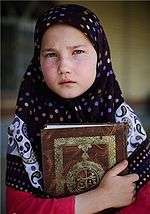Iranian Turkmen
Iranian Turkmen (Turkmen: Eýran Türkmenleri; Persian: ترکمنهای ایران) are a branch of Turkmen people living mainly in northern and northeastern regions of Iran. Their region is called Turkmen Sahra and includes substantial parts of Golestan.
 | |
| Total population | |
|---|---|
| 790,000 - 1,600,000 (1-2%)[1][2] | |
| Regions with significant populations | |
| Golestan Province, Razavi Khorasan Province and North Khorasan Province | |
| Languages | |
| Turkmen, Persian | |
| Religion | |
| Sunni Islam | |
| Related ethnic groups | |
| Other Turkic peoples and Khorasani Turks |
Ethnography
Iranian Turkmens have long time represented a group of semi-nomadic tribes who retained a more traditional way. In Iran lived next Turkmen tribes — Yomut, Goklen, Īgdīr, Saryk, Salar and Teke.
Turkmen tribes in Iran
Nearly two million Turkmen can be found living along the northern edges of Iran, just south of the Turkmenistan border. For centuries the Turkmen lived as nomadic herdsmen. In more recent years, however, many have changed to a "semi-nomadic lifestyle," living in permanent homes as well as in tents. Today most of them are farmers and cattle breeders. Turkmen still live in extended families where various generations can be found under the same roof, especially in rural areas. Many tribal customs still survive among modern Turkmen. Unique to Turkmen culture is kalim, which is a groom's "dowry" that can be quite expensive and often results in the widely practiced tradition of bridal kidnapping.
Famous Iranian Turkmen
- Magtymguly Pyragy, was a Turkmen spiritual leader and philosophical poet
- Haj Aghi Alejalil, was a Iranian philanthropist.
- Sardar Azmoun, is an Iranian footballer who plays for Zenit St. Petersburg in the Russian Premier League
- Farhad Ghaemi, is a volleyball player from Iran, who plays as a Spike for the Men's National Team
- Ezzatollah Pourghaz, is an Iranian footballer who plays for Esteghlal Khuzestan in the Persian Gulf Pro League
- Omid Kokabee, an experimental laser physicist
- Ramin Nourqolipour, an Iranian Turkmen politician and scientist who represented a part of Iranian Turkmen community in Iranian Parliament for four years between 2016-2020.
- Rahimberdi Annamoradnejad, is an Iranian urban planner.
See also
- Iranian Turks
- Turkmen Sahra
- Turkoman horse
- Music of Turkmenistan
References
- "Ethnologue". Retrieved 8 August 2018.
- CIA World Factbook Iran Archived 2012-02-03 at the Wayback Machine